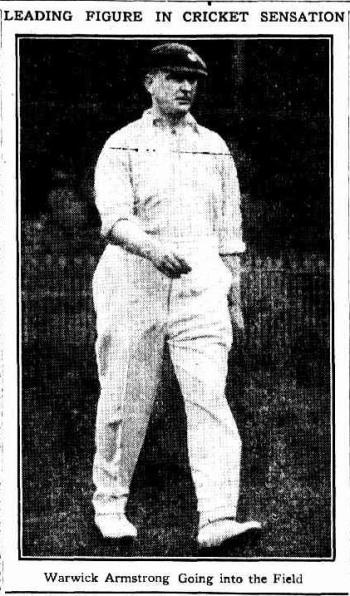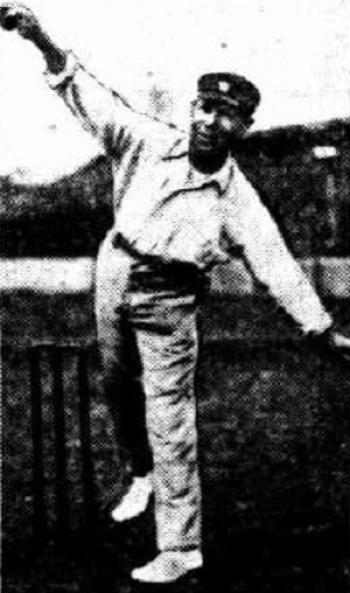The NFSA has identified rare footage of the 1920–21 Ashes Test series at the Melbourne Cricket Ground.


The NFSA has identified rare footage of the 1920–21 Ashes Test series at the Melbourne Cricket Ground.
Every so often, we discover an item in the NFSA collection previously thought to be lost or never to have existed. This occurred recently while examining the end of a 16mm film featuring cricket captain Bill Woodfull welcoming the English team to Australia before the start of the 1932–33 Ashes Test Series – what became known as the infamous Bodyline series.
The catalogue record described the footage as 'Cricket: Melbourne circa.1932', but in a short segment of less than a minute at the end there appears the figure of former Australian cricket player and captain Warwick Armstrong. At 1.9 m tall and weighing 133 kgs, Armstrong – nicknamed 'The Big Ship' – is unmistakable. His presence in the footage suggests it dates from the 1920–21 Ashes series a decade earlier:
The opening day of the fourth Ashes Test at the MCG, 11 Februrary 1921. Please note: this clip is silent. Courtesy: Roy Driver. NFSA title: 99107
The 1920–21 Ashes tour signalled a return to sporting normality following the upheaval of the First World War. This eagerly anticipated tour was the first Ashes series played in Australia since 1911–12 when England was captained by JWHT Douglas, who had replaced Sir Pelham Warner due to illness.

Douglas was dubbed ‘Alphabet’ in England and 'Johnny Won’t Hit Today' by Australian crowds because of his slow scoring rate. A sporting all-rounder, Douglas had also won a gold medal for boxing at the 1908 Olympics beating Australian Snowy Baker.
When the 1920–21 English team arrived in Fremantle on the SS Osterley the tour suffered an unfortunate setback. A case of typhus had been reported on board and they were required to quarantine for one week, depriving them of much-needed practice time after the long sea voyage. A century later, history is repeating itself with the current English men's cricketers also quarantining before a ball can be bowled because of COVID-19.
Having got off to an unfortunate start, the tourists were plagued by more bad luck with injuries to key players and controversy following comments by English team members ER Wilson and Percy Fender in the press, questioning umpires’ decisions and the behaviour of local supporters.
Although the Australian team fielded 7 debutants in the first test in Sydney, they proved unexpectedly strong. Most of these new players had recently completed a tour of England, South Africa and Australia with the AIF services team. In the test matches England’s weak bowling attack, batting collapses and poor fielding resulted in a first-time record Ashes series loss of 5–0.
The discovered footage comes from the first day of the fourth test match at the Melbourne Cricket Ground (MCG) on 11 February 1921. Spectator numbers appear to be low, perhaps because it was a hot and humid day and the fourth game the touring side had played at the MCG – having already played 2 tests and 2 games against Victoria.

We see the 2 captains – Warwick Armstrong of Australia and Johnny Douglas of England – walking off the field after tossing the coin. Douglas won the toss for the first time in the series and opted to bat first. The two umpires – Bob Crockett and David Elder – walk onto the field followed by the Australian team: Warwick Armstrong, Herbie Collins, Arthur Mailey, Sammy Carter, Ted McDonald, Jack Ryder, Nip Pellew, Charles Kelleway, Johhny Taylor, Warren Bardsley and Jack Gregory. Wicket-keeper Sammy Carter's presence helps to identify the film, as he only played in the fourth and fifth tests in Melbourne and Sydney during the series.
After a pause the English openers Jack Hobbs (in cap) and Wilfred Rhodes stride out onto the MCG to begin England’s first innings. There follows some long shots of the cricket action. We see Mailey bowling one of his leg breaks (possibly to Hobbs). Australian all-rounder Jack Gregory bowls several deliveries (possibly to Hobbs or Harry Makepeace), the last of which is played onto the leg side for 3 runs.
Despite the series having been decided by the time this film was made, interest in the match was still high. Final Australian team selections for the upcoming tour of England in 1921 had yet to be made and controversy surrounded the omission of Armstrong from the Sheffield Shield Victorian side due to injury. Public opinion was in support of the then 41 year-old and he responded on the field by rescuing Australia’s first innings with an unbeaten 123 runs. Remarkably this score was achieved while he was suffering from malaria and unable to take the field during England’s second innings.
Armstrong’s effort helped Australia to a first innings lead of 105 runs. England was effectively bowled out by Mailey in their second innings as he returned bowling figures of 9 for 121. This was a record for an Australian in test match cricket and remains a record over 100 years later. Needing 211 runs to win, Australia got the runs required for the loss of only 2 wickets.
Film footage of cricket from the 1920–21 series is exceptionally rare and to have identified footage from a game which included 2 significant performances from well-known cricketers of the period makes it a very special find.
Having won the home series Australia went on to win the first 3 test matches on tour in England – a then-record total of 8 tests in a row. After debuting in 1902, Warwick Armstrong retired at the end of the 1921 English tour as one of Australia’s most successful all-rounders and test match captains, having won 8 and drawn 2 tests.
Just like 100 years ago, despite facing quarantine and setbacks, it is anticipated that the 2021–22 Ashes series will bring many memorable moments to its numerous followers in Australia and abroad.
The National Film and Sound Archive of Australia acknowledges Australia’s Aboriginal and Torres Strait Islander peoples as the Traditional Custodians of the land on which we work and live and gives respect to their Elders both past and present.